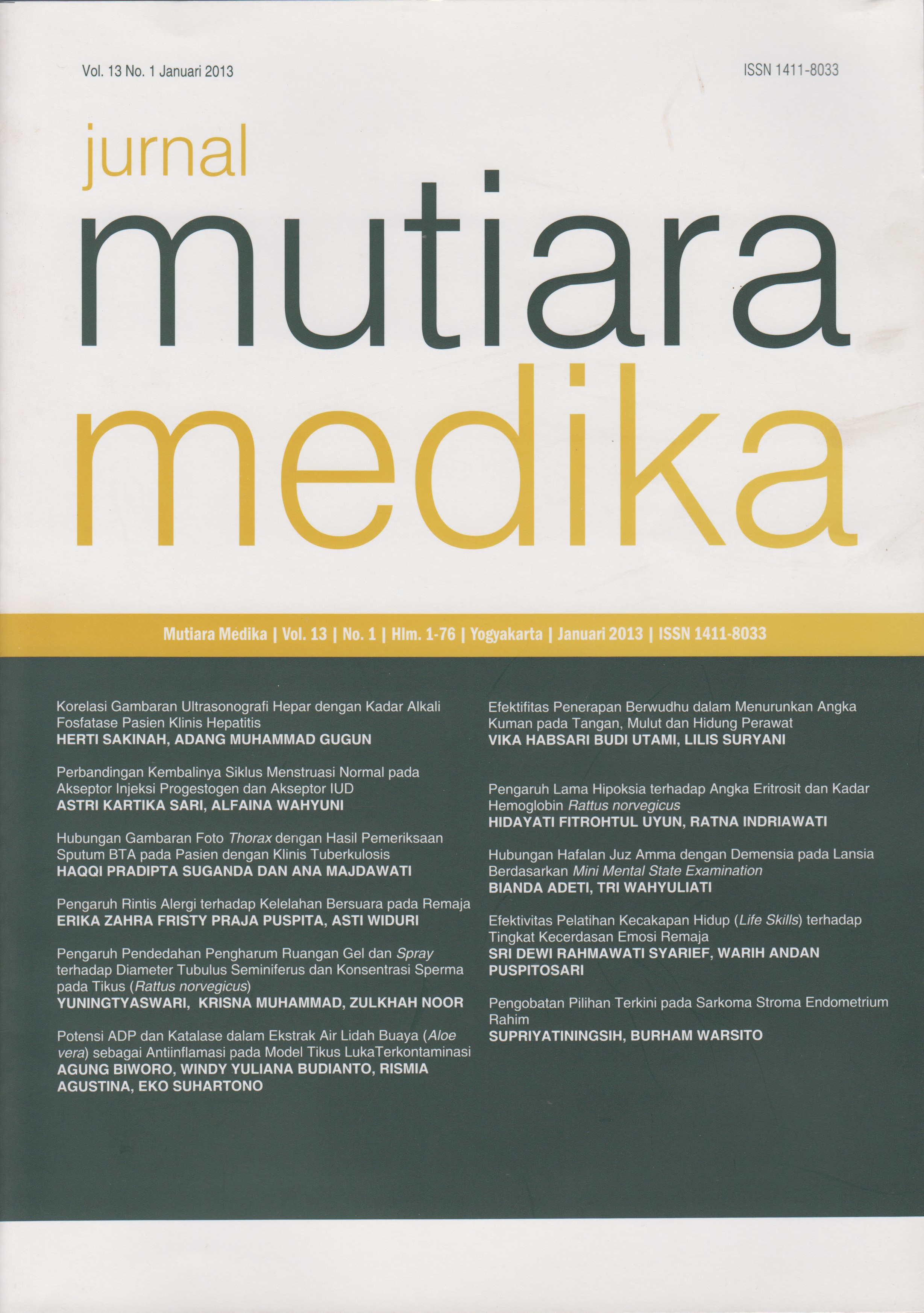Efektifitas Penerapan Berwudhu dalam Menurunkan Angka Kuman pada Tangan, Mulut dan Hidung Perawat
DOI:
https://doi.org/10.18196/mmjkk.v13i1.1055Keywords:
infeksi nosokomial, angka kuman, berwudhu, perawat, Nosochomial infection, the microbial count, wudhu, nurseAbstract
Tubuh manusia terdapat berbagai macam flora bakteri yang menetap. Pada instansi Rumah Sakit, masih banyak terjadi infeksi nosokomial. Berwudhu (thaharah) adalah membersihkan diri (mensucikan diri) dari hadats dan najis yang melekat pada tubuh manusia. Penelitian ini bertujuan untuk mengetahui efektivitas penerapan berwudhu dalam menurunkan angka kuman pada tangan, mulut dan hidung perawat di RS Nur Hidayah Yogyakarta. Penelitian kuasi eksperimental dengan rancangan Pretest-Postest group non control untuk membandingkan parameter kuman Staphylococcus sp dan Streptococcus sp sebelum dan sesudah berwudhu. Terjadinya penurunan jumlah angka kuman ditunjukkan dengan cara menghitung jumlah angka kuman yang telah diusap dari tangan, hidung dan mulut perawat pada media TSA yang telah dikultur masing-masing sebelum dan sesudah berwudhu. Hasil penelitian menunjukkan bahwa terjadi penurunan jumlah angka kuman Staphylococcus sp pada mulut perawat dengan nilai p=0,002 ( p<0,05) dan penurunan jumlah angka kuman pada hidung perawat dengan nilai p=0,000 (p<0,05). Disimpulkan bahwa terjadi penurunan angka kuman yang bermakna sebelum dan sesudah wudhu terhadap kuman Staphylococcus sp pada mulut dan hidung perawat dengan penerapan berwudhu sesuai dengan tatacara yang benar.
In the human body there are various kinds of flora bacteria residing. Hospitals in the institution, it happen so many nosochomial infection. Wudhu (thaharah) is cleaned up (purify themselves) from hadats and unclean attached to the human body. This research aims to determine the effectiveness of implementation wudhu in reducing germs on hands, mouth and nose to nurse at Nur Hidayah Hospital in Yogyakarta. This study was quasi-experimental, pretest-posttest non control group design to compare the parameters of Staphylococcus sp and Streptococcus sp before and after wudhu. The decrease in the total number of bacteria was shown by calculating the total microbial count that have been rubbed out of the hands, nose and mouth nurses have on TSA media cultured respectively before and after wudhu. The results of this study indicate that a decline in the total number of bacteria in the mouth nurse Staphylococcus sp with p = 0.002 (p<0.05) and a decrease in the total number of bacteria in the nose nurse with p = 0.000 (p<0.05). Concluded that there was a significant decrease in the number of germs before and after the Staphylococcus sp in the mouth and nose nurse with the application of ablution in accordance with the correct procedures.
References
Frost & Sullivan. Hospital-acquired Infection – Trends Across Europe. 2010 . Diakses 2 April 2012, dari http://www.sicherheitimop.at/documents/FrostSullivanHospitalInfectionsTrendsacrossEuropeJuni2010.pdf.
Sukartik. Hubungan Faktor-faktor Eksogen dengan Tindakan Pencegahan Infeksi Nosokomial di Ruang Rawat Inap Bedah RSU Daerah Dr. Pirngadi Kota Medan. Tesis. Medan: Universitas Sumatera Utara. 2009.
DeNoon, D.J. CDC Finally Gets Data as State Laws Force Hospitals to Count Infections. WebMD Health News. 2010. Diakses 2 April 2012 , dari www.medicinenet.com/script/main/ art.asp?articlekey=116699#.
Gillespie S.H & Bamford K.B. Medical Microbiology and Infection At a Glance (3rd. Ed) ( S.Tinia, Trans.). Jakarta: Erlangga. 2009. ( Original work published 2007).
Jawetz, E., Melnick, J.L, & Adelberg, E.A, Mikrobiologi Kedokteran (23th Ed) (E. Nugroho & R.F. Maulany, Trans.). Jakarta : BukuKedokteran EGC. 2008.
Rahmawati, F.J., & Triyana, S.Y. Perbandingan Angka Kuman pada Cuci Tangan dengan Beberapa Bahan Sebagai Standarisasi Kerja di Laboratorium Mikrobiologi FK UII. Jurnal Logika, 2008; 5 (1): 1-13.
Loho, T., & Utami, L. Uji Efektivitas Antiseptik Triclosan 1% terhadap Satphyloccocus aureus, Escherichia coli, Enterococcus faecalis, dan Pseudomonas aeruginosa. Artikel Penelitian FK UI. 2007.
Setiyono. Efektivitas Lama Wakyu Kontak Antiseptik Irgasan DP300 0,1% dalam Menurunkan Angka Kuman pada Tangan Petugas Kesehatan di Instalasi RS Panti Wilasa Citarum. Undergraduate Thesis, Diponegoro University. 2004.
Habni, Y. Perilaku Perawat dalam Pencegahan Infeksi Nosokomial di Ruang Rindu A, Rindu B, ICU, IGD, Rawat Jalan di Rumah Sakit Umum Pusat Haji Adam Malik Medan. Skripsi. Medan: Program Studi Ilmu Keperawatan FK Universitas Sumatera Utara. 2009.
Gisymar, S. Terapi Wudhu. Surakarta: NUUN. 2002.
Downloads
Published
Issue
Section
License
Copyright
Authors retain copyright and grant Mutiara Medika: Jurnal Kedokteran dan Kesehatan (MMJKK) the right of first publication with the work simultaneously licensed under an Attribution 4.0 International (CC BY 4.0) that allows others to remix, adapt and build upon the work with an acknowledgment of the work's authorship and of the initial publication in Mutiara Medika: Jurnal Kedokteran dan Kesehatan (MMJKK).
Authors are permitted to copy and redistribute the journal's published version of the work (e.g., post it to an institutional repository or publish it in a book), with an acknowledgment of its initial publication in Mutiara Medika: Jurnal Kedokteran dan Kesehatan (MMJKK).
License
Articles published in the Mutiara Medika: Jurnal Kedokteran dan Kesehatan (MMJKK) are licensed under an Attribution 4.0 International (CC BY 4.0) license. You are free to:
- Share — copy and redistribute the material in any medium or format.
- Adapt — remix, transform, and build upon the material for any purpose, even commercially.
This license is acceptable for Free Cultural Works. The licensor cannot revoke these freedoms as long as you follow the license terms. Under the following terms:
Attribution — You must give appropriate credit, provide a link to the license, and indicate if changes were made. You may do so in any reasonable manner, but not in any way that suggests the licensor endorses you or your use.
- No additional restrictions — You may not apply legal terms or technological measures that legally restrict others from doing anything the license permits.






